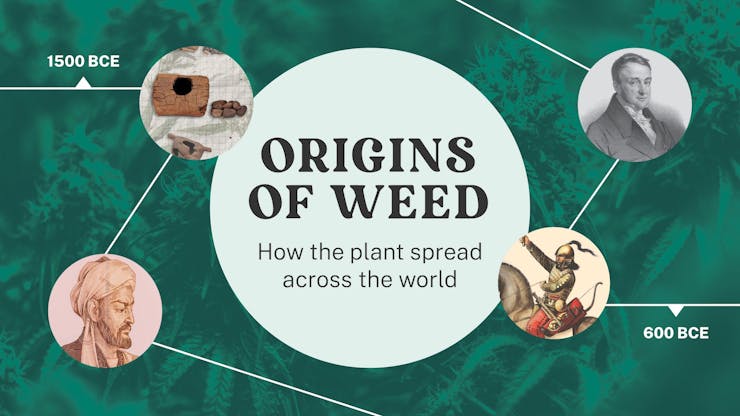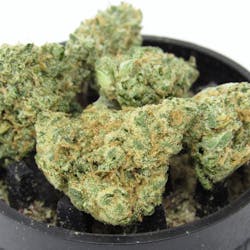Cannabis has grown and evolved with humans for thousands of years. Many separate cultures cultivated the plant, using its seeds for food, its fibers to make textiles, rope, and other materials, and its buds as a medicine and psychoactive substance in spiritual ceremonies. Cannabis proved to be a very useful plant for our ancestors and it continues to be today.
If there was one thing our ancestors knew, it was the healing properties of cannabis. While the wonders of cannabis medicine may feel like a new discovery in the West, cultures in the East have used and documented it for thousands of years.
Check out the story of cannabis—where it originated, how it spread across the globe, and which cultures used it. Learn how important the plant was to ancient humans and how it continues to be important to humans today.

Where did weed first grow wild?
Cannabis likely originated in Central Asia, in parts of China, Mongolia, Russia, Kazakhstan, Pakistan, and India. Humans began practicing agriculture about 10,000 years ago, and cannabis is believed to have been cultivated by humans 5,000 – 6,000 years ago. In prehistoric times, as weather warmed and humans migrated, they brought cannabis with them, spreading the plant far and wide.
From Central Asia, cannabis is believed to have spread to the Middle East and the east coast of Africa, as well as to Southeast Asia. It would eventually make its way to Europe and the Americas hundreds of years later.
Different types of cannabis started to develop in specific regions—these are called landraces today. These strains, such as Hindu Kush, from the Kush Mountains of Pakistan and Afghanistan, are native to a specific region and are influenced by that region’s climate, geography, soil, and environment.
Medicinal cannabis in ancient China
The world’s oldest text on medicine, the Pen-ts’ao Ching,first became prominent during the late Han Dynasty, in the second century CE, but was compiled from ancient texts. It refers to Emperor Shen-Nung, the father of Chinese medicine, who lived around at least 2000 BCE, who recognized the benefits of cannabis for over 100 ailments. The Pen-ts’ao Ching represents the earliest record of cannabis as a medicinal drug, emphasizing the plant’s healing potential, and how safe it was to use.
A concoction of female cannabis flowers is referred to as “ma-fen,” in the Pen ts’ao Ching. Chinese medicine is premised on yin and yang, and cannabis was viewed as a medicine that restored yin, useful for conditions such as gout, rheumatic pain, constipation, malaria, and gynecological disorders.
Note that “hemp” and “cannabis” are interchangeable in ancient texts. Today, we define “hemp” as cannabis plants with less than 0.3% delta-9 THC, but our ancestors did not make this distinction. Hemp fiber was used to create materials, its seeds for food, and its buds for medicinal or spiritual practices.
Linguistic analysts even tell us that medicinal cannabis influenced certain Chinese compound words, including the words for “numb,” “narcotic,” and “paralysis,” which are all formed with the word “má,” meaning “hemp,” and which can describe the effects of cannabis.
In 2019, scientists discovered a wooden brazier dating back to around 1500 BCE. Ten of these devices were found at a cemetary in the Eastern Pamir region of China, suggesting they were part of a burial ceremony. These braziers were pieces of wood with deep wells carved into them, and the charred residue inside contained traces of cannabinoids. Cannabis and a heated rock would be placed inside the braziers and the smoke inhaled.
Shop highly rated dispensaries near you
Showing you dispensaries nearAdditionally, another use of cannabis pops up in China centuries after the time of the wooden braziers, in documents from the Han Dynasty (200 BCE – 220 CE). They describe the pain-relieving properties of cannabis based on the work of a renowned surgeon, Hua Tuo, who performed surgeries without inflicting pain on his patients due to his application of “máyóu,” an oil infused with cannabis resin, datura, and wine.
Cannabis in India: Sacred medicine and Ayurveda
Cannabis features prominently in the Atharva Veda, a collection of holy writings in Sanskrit dating back to at least 800 BCE, if not earlier. The text mentions cannabis as one of five sacred plants, its medicinal uses merged with religious and ritual practices. It was recognized as a source of happiness and a bringer of joy and freedom.
The plant was also described in the Susrita Samhita, a foundational text of Ayurvedic medicine from around 800 BCE, which explains the plant’s many healing properties. Cannabis was used for a staggering range of treatments: as an appetite stimulant, pain-reliever, anesthetic, anticonvulsant, and antiparasitic, among others.
Bhang, a drink made of cannabis, warm milk, nuts, and spices, was a common remedy for ailments and also thought to be a favorite food of the god Shiva. Bhang was considered highly effective at relieving anxiety and is still consumed in sacred contexts such as during the Holi festival.
Other medicinal and sacred preparations of cannabis include ganja, or smoking the female flowers, and charas, rolled balls of hash that are smoked. These forms of cannabis are still consumed in the present day, albeit under the radar.
Shemshemet in ancient Egypt
Historians tell us that cannabis found its way to Egypt from Central Asia, with medical records written on papyrus in 1550 BCE highlighting the plant’s anti-inflammatory properties and its use as an aid in childbirth. The Egyptians administered cannabis creatively—by the mouth and skin, but also by the rectum, vagina, and in the eyes.
Many scholars think a word found in many Egyptian hieroglyphs, “shemshemet,” refers to a plant used both for rope and medicine—likely hemp. Remains of the plant have also been found in the tombs of pharaohs, including Akhenaten, or Amenhotep IV, who lived around 1335 BCE, and Ramses II, who lived from 1303–1212 BCE.
The Scythians of Central Asia
The Scythians were an ancient nomadic people who lived around 600 BCE – 400 CE, in a large expanse of land in Central Asia, between the Black Sea and Siberia. Greek historian Herodotus observed a “Scythian vapor bath,” in which people would sit inside a tent and place cannabis and heated rocks in wooden braziers—perhaps the world’s first recorded hot box.
The “Siberian Ice Maiden” dates back to 500 BCE and is believed to have treated her breast cancer with cannabis.
Two gold bongs dating to around 600 BCE were also found in Central Asia and are thought to belong to the Scythians.
A mummified body of a woman was also found in the Altai Mountains of southern Siberia, dating back to around 500 BCE. Named the “Siberian Ice Maiden,” she was buried with a pouch of cannabis. An MRI scan in the present revealed she had breast cancer; scientists theorize that she might have used cannabis for her condition.
Cannabis in Greece and Rome
Greeks and Romans commonly used cannabis for rope and sails, and the earliest surviving account of medicinal cannabis among the Greeks is an entry in the De materia medica, written by the physician Dioscorides, around the first century CE. Dioscorides sings the plant’s praises as a treatment for earache and offers specific instructions of how cannabis medicine should be prepared as a juice from young, green cannabis seeds.
Dioscorides’ recognition of cannabis as a medicine was followed closely by Pliny the Elder’s entry in Naturalis Historia in 77 CE. Pliny discussed the medical use of cannabis for aching joints, gout, and burns.
Galen, physician to Roman Emperor Marcus Aurelius, who lived in the second century CE, warned of eating too many cakes containing hemp seeds, which were known to be popular at Roman banquets for their ability to create relaxation, hilarity, and euphoria. He said they also induced thirst, made one sluggish, and made it difficult to digest.
Hashish in the Arab and Persian worlds
Several hundred years later, in an area that was once part of the Roman Empire, Arabic scholars al-Mayusi (living around 1000 CE) and al-Badri (living in the 15th century CE) called attention to cannabis as an effective treatment for epilepsy. Additionally, Avicenna, a highly regarded Persian scholar who published his celebrated Canon of Medicine in 1025 CE, acknowledged cannabis as a useful treatment for pain relief, gout, edema, infectious wounds, and eye inflammation.
Persian scholars had a sophisticated understanding of marijuana and were aware of its biphasic effects at different doses—how a little bit of THC can create positive effects, but a lot can create different, possibly negative, effects.
Persian scholars were some of the first to note that a little bit of THC can create positive effects, but a lot can create different, possibly negative, effects.
Also, the first cannabis edible is thought to have originated in Morocco: mahjoun, a sweet treat filled with hash. A traditional version includes a paste of figs, dates, and hash, covered with nuts and other flavorings such as honey, rosewater, sea salt, turmeric, cardamom, ginger, cinnamon, and lavender.
Cannabis in Africa
The plant is widely believed to have been introduced to East Africa from India and the Middle East by Arabic traders, at least since the 1400s. Cannabis was known to be a part of the culture of enslaved Africans in Brazil, presumably brought over from Africa, especially the area of Angola today, in West Africa.
Weed in Europe
Cannabis may have arrived in Europe via the Scythians of Central Asia, with the plant possibly making its way from east to west via the “Bronze Road,” which would later become known as the Silk Road. Hemp has also been found in Germanic burials dating back to 500 BCE.
In the 8th-15th centuries CE, after cannabis had made its way to the Middle East from its origins in Central Asia, Arabic traders are thought to have spread the plant throughout North Africa and into Spain, which were parts of various Arab or Berber states.
The Anglo Saxon Old English Herbarium was one of the first texts to document cannabis usage in Europe, written in the 11th century CE. The Herbariumdescribes cannabis as an anesthetic and pain reliever, and was also used to help with gout, urinary infections, childbirth issues, and weight loss.
Cannabis is also mentioned in the 12th century medical texts of German Hildegard von Bingen, seer, scholar, physician, and abbess.
More records of cannabis occur in 1484, in a papal bull condemning the plant, issued by Pope Innocent VIII. However, several maritime republics are thought to have ignored it, as they relied on the plant’s fiber for making rope and sails. During the Italian Renaissance it was used for paper and canvas.
Hemp medicinal usage was also recorded in medical texts in England as early as the 1500s, during the reign of the Tudors.
Smoking cannabis for its psychoactive effects, in particular hashish, became popular in Europe after Napoleon’s 1798 campaign in Egypt, where French troops were encouraged to embrace hashish. Bringing the plant back home, cannabis use spread throughout Europe in the modern age, where it was used to treat a variety of ailments.
Weed spreads to the Americas
Cannabis hopped across the Atlantic Ocean to the Americas a few different ways. It was first thought to have crossed over via the Spanish, after their invasion of the Americas beginning in 1492.
Cannabis is believed to have first come to the Americas via the Spanish, during their invasions beginning in 1492.
Hemp is thought to have first shown up in North America in the early 1500s, when Hernán Cortés and his Spanish soldiers invaded Mexico. Soldier Pedro Cuadrado and a friend started a successful business growing hemp there. However, in 1550, a Spanish governor restricted production because the locals were getting high with the plant rather than using it for rope and textiles.
Further north in the 13 colonies, King James I of England enacted a royal decree in 1611 that instructed the colonists of Jamestown, Virginia, to grow hemp. Hemp was a valuable crop for many colonists, as it could be used to make rope, sails, clothes, textiles, and other materials.
As mentioned previously, cannabis is also thought to have come to South America, in particular Brazil, via enslaved Africans, around the 16th century. After the abolition of slavery in British colonies in 1834, it is thought that Indian indentured servants brought cannabis to the Caribbean. “Ganja,” a term originating in India, became especially popular in Jamaica, a British colony at the time, where it is still commonly consumed today.
Medical cannabis in the West in modern times
As interest in cannabis increased in the 19th century, the plant was brought to the attention of Western medicine in 1839, when Irish doctor William O’Shaughnessy published On the Preparations of the Indian Hemp, or Gunjah. He had worked in India and experimented with the plant and its uses there, noting its success as a treatment for rheumatism, convulsions, and spasms associated with tetanus and rabies.
In France, psychiatrist Jacques-Joseph Moreau experimented with hash, theorizing that it could help treat mental illness. Moreau wrote a book called Hashish and Mental Illness. The work of O’Shaughnessy and Moreau had a significant impact on Western medicine.
In the latter half of the 19th century, more than 100 studies were conducted on the plant, and pharmaceutical companies in the US and Europe began creating and marketing cannabis tinctures. Medicines containing cannabis became widely available to the general public, with many brands claiming to cure a variety of ailments.
In the late 19th and early 20th centuries, views of cannabis began to shift and many countries began outlawing the plant, most notably, the US.
To continue the story of cannabis and how it was criminalized, check out our History of cannabis prohibition.





